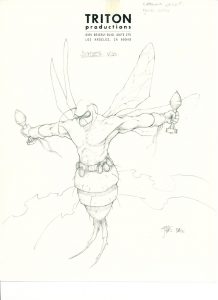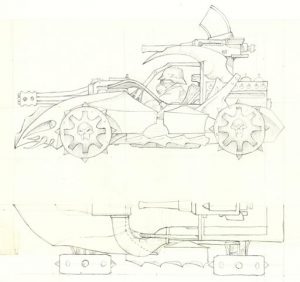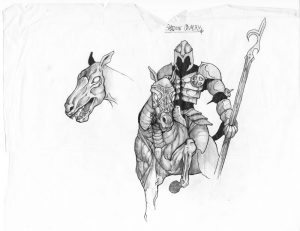 The Saturn was known for its trials and tribulations with 3D, but some developers were able to make the hardware do some remarkable things. Scavenger was one such company, and Saturn owners have likely played at least one of the two titles developed by its team, Lemon, and released on the platform, Amok and Scorcher. Founded in Søren Hannibal and Jacob Andersen in 1994, Lemon was only around for a few short years.
The Saturn was known for its trials and tribulations with 3D, but some developers were able to make the hardware do some remarkable things. Scavenger was one such company, and Saturn owners have likely played at least one of the two titles developed by its team, Lemon, and released on the platform, Amok and Scorcher. Founded in Søren Hannibal and Jacob Andersen in 1994, Lemon was only around for a few short years.
Jacob Andersen served as designer on both titles, having started his career in game design as a freelance CG artist. He then landed a job at Core Design before starting Lemon a year later. After the developer folded, he went on to work on multiple game franchises, including the Hitman series at IO Interactive, which he co-founded. He then started Reto Moto, the makers of the World War II game Heroes & Generals that reached 10 million subscribers in 2017.
We were fortunate to chat with Mr. Andersen for a while about his work on Lemon’s two Saturn titles.
Sega-16: How did you get into doing game art? Was it something you started on your own, or did you first start when you became a professional artist?
Jacob Andersen: I guess it began when I got bored of playing games on my C128 and started looking into what else I could use it for. At first, it was just simple two color sprites but I soon began copying Iron Maiden posters. ? At the time I spend just as much time coding, but when I eventually moved on the the Amiga I started creating more art than code (mainly because I got into a demo group where the coders were WAY better than me).

Sega-16: At Core Design, you were behind the art and design of the stellar Amiga shooter Banshee, but you departed after only a year at the company? That was to found the game development company Lemon, correct? I’ve read that the company was born out of the European Amiga demo scene.
Jacob Andersen: That is correct. When I worked at Core (together with Søren Hannibal), I received a call from Karsten Hvidberg, who had just moved to Boston together with a bunch of guys from the Danish demo scene (mainly Silents/Crionics). They were looking to get as many people to join them in the U.S. as possible, and Søren and I thought that sounded really interesting but we had to finish our game at Core before we could move. So, we did.
The reason for founding a company was more related to the way Scavenger was set up. It made it much easier for us to get a visa in the U.S. at the time if we posted employees of a Danish company. The name Lemon came from the demo group, Lemon that we were part of at the time (I don’t recall that we ever asked the other guys to use the name though?).
Sega-16: I’ve read that you were involved with the famous 32X Demo Tape. Is that true? If so, what was your role and how did you become a part of it?
Jacob Andersen: I did a small part on that, mainly the graphics for the voxel landscape. The tape was used as a promotion of the team(s) in Scavenger. In those days it was much easier to just send a video tape around than a CD (which was also “hi tech”). Mikael Balle had been working at Nordisk Film and he had experience with video editing, so he made most of that tape.
Sega-16: Were you a part of the team behind the 32X combat racer Heavy Machinery? Do you know anything about that game’s development? It was reportedly almost finished before it was canceled.
Jacob Andersen: I was not part of that team, although we worked at the same office. As I recall, the game went through several transformations, it was at some point called Nitrowrecks and at another point 4xFrenzy. I do not know why it was cancelled, though, I think it had something to do with Sega having too many racing games but I’m not sure. The team went on to create a rather awesome game called Terminus under the team name Fetus – very dark and goth with some cool semi-3D-nurbs-tech for character rendering. I remember that being particularly cool because the characters could be created in hi-res and then converted into these ‘3D sprites’ which gave the artists (Mike Damien and Darran Hurlbutt) a lot of freedom. This game was ultimately also cancelled because Scavenger went bust, but Saxs (the programmer) managed to bring the pieces to Shiny Entertainment where the game was finished and released as Messiah.
Sega-16: Lemon was able to get both of the Saturn’s Hitachi processors to work together, something few developers were able to do. What kinds of challenges did the hardware present to you while creating the graphics engine?

Jacob Andersen: I think the first question might be better answered by Søren Hannibal.
Other challenges were more self-created misery. Søren had programmed this cool voxel landscape routine (“without the use of any square-root calculations,” I remember him bragging) but there was absolutely no memory on the Saturn for a large terrain heightmap (as you would see in PC voxel games of the time like Comanche), so we had to resort to building the landscape out of tiles (in the same way as you would create a normal 2D game). Creating those tiles were rather difficult because I had to work in 8-bit greyscale and it was bloody hard to distinguish the shades from each other on the rather poor monitors we had at the time. I literally had to constantly use the color picker to check that the values were identical between tiles to avoid ridges. I did have my own Saturn Dev-kit though, which made it easier, but I had to constantly run the game to test the graphics.
Sega-16: Amok was Lemon’s first game for the Saturn. Reportedly, it started out as a 32X game and was shifted to Saturn when Sega discontinued the add-on. Is this true? If so, how far along was the game on the 32X?
Jacob Andersen: As I remember, it was more a question of the Saturn becoming a valid option, so we decided to switch. I don’t remember it being very far, so it wasn’t a big deal. At the time, there was no PlayStation in sight so I guess everybody thought that this was the future platform. We did eventually start converting the game to the PlayStation along with the PC, but the project fell apart at Scavenger’s ultimate demise.
Sega-16: Scorcher took a different approach to the racing genre, with a unique visual style and challenging track design. What inspired you to create the game’s dark, urban landscape?
Jacob Andersen: Well, the graphics was created by Mikael Balle, but he left the project so in all honesty I just took over and finished the game in the style he created. I did do the graphics for “The Spiral” from scratch though. 🙂
Sega-16: How did you approach the design of Scorcher after Amok? Were there any lessons that you feel perhaps helped Scorcher’s development?
Jacob Andersen: The two games were created pretty much in parallel but used very different tech. I used Amiga for most of the graphics for AMOK, Brilliance for 2D, and Imagine for the 3D. The level graphics on Scorcher were created in 3D Studio on PC, so I had to switch hardware completely. The tracks was texture-mapped and lit in 3D Studio and then a small image was “rendered/baked” out for each triangle and then packed into a tight data chunk that could be run on the Saturn. It was a bit easier to work with than the AMOK structure because the rendering/baking process took care of memory consumption. If the track took up too much memory we could either dial down the texture resolution or remove some graphics, so it was a bit more flexible. I also had the option to mark certain parts of the tracks as duplicates for further optimization.
Sega-16: Scavenger had a few other titles in development when it closed, including the platform game Angel and the first-person Into the Shadows? These two seem to be most far along (I couldn’t find any screens shots for Mudkicker or Tarantula). Could you give us some information about these titles?
Jacob Andersen: The game Into the Shadows was developed by a bunch of Swedish guys, headed by Magnus Högdahl. They were also working at the same office as us. Really cool guys. Into the Shadows was PC only and it showed off some impressive tech, but it seemed to never get beyond being a cool tech demo. When Scavenger closed down, they all went back to Sweden where Magnus founded Starbreeze Studios. I’m not totally sure about this, but it seems like Into the Shadows somehow ended up being the game Enclave… similar game but probably a few generations further tech-wise ?

The game Angel was developed by me and Søren. It was based on a story of a demon-girl and her demon-dog (more like monster-wolf) and their journey to escape hell. Lots of demons and crazy stuff. No good guys, just demons. We managed to create a semi-playable demo for E3, but the game was put on hold (scrapped) when Scavenger went down. We joined the remaining members of Zyrinx and Lemon into one team and some of the elements ended up in a demo for a game called Rex Dominus (open world fantasy with dragons and trolls). We ended up using the Rex Dominus demo to convince Nordisk Film into creating IO Interactive with us. Nordisk Film were nervous that Rex was far too ambitious and asked us to make a simple shooter first. We then created Hitman: Codename 47 (which wasn’t in any way simple).
Sega-16: What are your thoughts on Scavenger’s legacy? The company was renowned for its ability to push hardware to its limit with innovative game design, but the Saturn’s technical and sales problems likely kept it from reaching a broader console audience. Do you think things would have been different if Amok and Scorcher had made it to the PlayStation?
Jacob Andersen: There was an incredible amount of very, very talented guys at working at Scavenger (although most would probably identify more with the teams than Scavenger). A lot of them went on to create other great games and technology after Scavenger. I am not sure things would have been much different had we managed to release the two games on PlayStation. I think the main problem was that the management was too focused on empire building instead of getting some product shipped. Amok and Scorcher were the only two games that were ever finished. The teams mainly consisted of developers with no experience in actually finishing a game (Zyrinx and Lemon had released games prior to Scavenger), and the management did nothing to provide the teams with proper production expertise (producers), so the games just kept being developed but never finished.
Our thanks to Mr. Andersen for making time for this interview.

Recent Comments